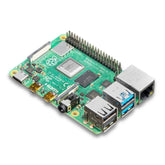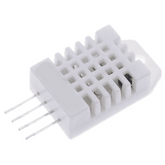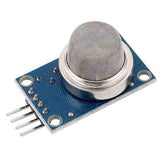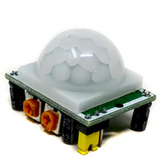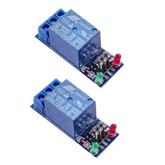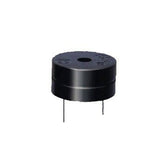Getting Started with IOTIF - IoT Trainer Kit with Pi 4B 4GB
Summary
The Internet of Things is reshaping how we interact with the world around us. From smart homes to industrial automation, IoT is everywhere.
But where do you start if you want to build your own IoT projects? That's where the IOTIF IoT trainer kit comes in.
This comprehensive learning platform combines powerful hardware with practical components, giving you everything needed to transform theoretical knowledge into hands-on experience.

What is the IOTIF – IoT Trainer Kit with Raspberry Pi 4B?
The IOTIF IoT trainer kit is a complete IoT learning platform with Raspberry Pi designed specifically for students, hobbyists, and professionals who want to dive deep into Internet of Things development.
At its heart lies the Raspberry Pi 4B 4GB RAM, a powerful single-board computer that serves as the brain of your IoT experiments.
Unlike basic starter kits that only scratch the surface, this IoT development kit provides a full-fledged learning environment where you can design, prototype, and deploy real-world IoT applications.
What makes this kit stand out is its integration of multiple sensors, actuators, and connectivity modules on a single platform.
Rather than scrambling to connect individual components with jumper wires and breadboards, the IOTIF kit offers a clean, organized interface where everything works together seamlessly.
It's essentially a bridge between classroom theory and practical implementation, allowing you to focus on learning concepts rather than troubleshooting hardware connections.
The kit is specifically engineered for the Indian market, addressing the unique needs of engineering students and makers who want to understand IoT fundamentals without breaking the bank.
Whether you're working on a college project, preparing for IoT lab courses, or simply exploring the field out of curiosity, this IoT trainer kit for students provides a structured pathway to mastery.
Key Features
The IOTIF kit isn't just another collection of sensors thrown together—it's a carefully designed Internet of Things training platform with features that accelerate your learning curve:
Integrated Sensor Array
The kit comes with an impressive range of pre-mounted sensors that cover virtually every common IoT application. Temperature and humidity sensors let you monitor environmental conditions, while motion detectors enable you to build security systems.
Gas sensors can detect harmful gases, making them perfect for safety applications, and light-dependent resistors allow you to create light-responsive projects. This variety ensures you can experiment with multiple IoT scenarios without purchasing additional components.
Cloud Connectivity Ready
One of the most exciting aspects of modern IoT simulation and cloud connectivity is the ability to monitor and control devices remotely.
The IOTIF kit is designed to work seamlessly with popular cloud platforms, allowing you to send sensor data to the cloud, visualize it in real-time, and even trigger actions based on predefined conditions. This feature transforms your local experiments into globally accessible IoT applications.
Raspberry Pi 4B Power
With 4GB of RAM and a quad-core processor, the Raspberry Pi 4B at the core of this kit provides enough computational power to run complex algorithms, machine learning models, and multiple services simultaneously.
This means you're not limited to simple sensor reading—you can process data locally, make intelligent decisions, and even run computer vision applications.
Beginner-Friendly Design
Despite its advanced capabilities, the kit maintains a beginner-friendly approach. All major components are clearly labeled, and the board layout is intuitive.
You don't need to be an electronics expert to get started with IOTIF kit—the design minimizes the chances of incorrect connections and component damage.
Expandable Architecture
As you grow more confident, you'll appreciate the kit's expandability. Standard GPIO pins remain accessible, allowing you to integrate additional sensors, actuators, or custom modules.
This means your IoT prototyping kit India investment continues to provide value as your skills advance.
Specifications
Understanding the technical specifications helps you appreciate what this practical IoT learning kit can accomplish:
Processing Unit
- Raspberry Pi 4 Model B with 4GB LPDDR4 RAM
- Broadcom BCM2711, Quad-core Cortex-A72 (ARM v8) 64-bit SoC running at 1.5GHz
- Dual-band 2.4GHz and 5GHz IEEE 802.11ac wireless connectivity
- Bluetooth 5.0, BLE (Bluetooth Low Energy)
- Gigabit Ethernet for wired network connections
Onboard Sensors and Modules
- DHT11/DHT22 temperature and humidity sensor
- MQ series gas sensors (MQ2/MQ3/MQ5)
- PIR motion sensor for detecting human movement
- LDR (Light Dependent Resistor) for ambient light sensing
- Ultrasonic distance sensor (HC-SR04 compatible)
- OLED/LCD display interface for local data visualization
- Relay modules for controlling AC/DC appliances
- Buzzer and LED indicators for alerts and status
Power Requirements
- 5V DC power supply with minimum 3A current rating
- USB Type-C power delivery support
- Separate power options for high-current peripherals
Connectivity Options
- Multiple USB 3.0 and USB 2.0 ports for peripherals
- HDMI output for display connectivity
- 40-pin GPIO header with standard Raspberry Pi pinout
- I2C, SPI, and UART interfaces for advanced communication
List Components Included in the IOTIF Trainer Kit Pi 4B
When you open the IoT Kit box, you'll find a comprehensive set of components that work together to create a complete learning environment:
Core Computing Module
- Raspberry Pi 4B (4GB RAM variant)
- Custom IOTIF interface board with mounted sensors
- MicroSD card (typically 16GB or 32GB) with pre-installed operating system
- Official power adapter with adequate current rating
Sensors Suite
- Temperature and humidity sensor (DHT11 or DHT22)
- Gas sensor module for detecting smoke, LPG, and other gases
- PIR motion sensor for detecting movement
- Ultrasonic distance sensor for proximity detection
- Light sensor (LDR) for brightness measurement
- Sound sensor for noise level detection
Output and Control Devices
- Relay module (typically 2-4 channels) for controlling external devices
- OLED or LCD display module for showing sensor readings
- LED array for visual indicators
- Buzzer for audio alerts
- Fan module for demonstrating motor control
Connectivity Components
- USB cables for programming and data transfer
- HDMI cable for connecting to a monitor
- Ethernet cable for wired network access (if applicable)
Accessories and Documentation
- Jumper wires and connectors (if additional connections are needed)
- Mounting hardware or enclosure components
- Quick start guide with basic setup instructions
- Component identification chart
This comprehensive component list makes the IOTIF an excellent IoT Starter Kit because you don't need to source individual parts or worry about compatibility issues.
How to Set Up the IOTIF Kit Pi 4B 4GB
Getting started with IOTIF kit is straightforward, even if you've never worked with a Raspberry Pi before. Follow these steps to have your IoT learning kit up and running:
Initial Hardware Setup
Begin by carefully removing all components from the packaging and identifying each piece using the included documentation. Connect the IOTIF interface board to the Raspberry Pi 4B using the 40-pin GPIO header.
Ensure the connection is firm and properly aligned—misalignment can damage pins. If the kit includes a case or mounting plate, assemble these components according to the instructions to protect your hardware.
Insert the provided microSD card into the Raspberry Pi's card slot. This card typically comes with a pre-installed operating system, often Raspbian or a customized version with necessary IoT libraries pre-configured.
If you need to set up the card yourself, download the latest Raspberry Pi OS from the official website and use software like Raspberry Pi Imager to write it to the card.
Power and Display Connection
Before powering up, connect a monitor using the micro-HDMI port on the Raspberry Pi. You'll also need a USB keyboard and mouse for initial configuration.
Once these peripherals are connected, plug in the USB Type-C power supply. The Raspberry Pi should boot up within 30-60 seconds, displaying the operating system desktop on your monitor.
Network Configuration
For IoT experiments with sensors that involve cloud connectivity, you'll need internet access. You can connect via Wi-Fi by clicking the network icon in the top-right corner of the desktop and selecting your network, or use an Ethernet cable for a wired connection.
A stable internet connection is essential for updating software packages and connecting to cloud platforms later.
Software Installation and Updates
Open the terminal application and run system updates to ensure you have the latest software packages. This is a crucial step for security and compatibility. Install Python libraries commonly used in IoT learning with Raspberry Pi, such as RPi.
GPIO for controlling GPIO pins, Adafruit libraries for sensor interfacing, and MQTT clients for communication protocols. Many of these might already be pre-installed if using a customized SD card image.
Testing Basic Functionality
Before diving into complex STEM projects, test individual components to ensure everything works correctly. Start with simple tasks like turning an LED on and off using Python code, reading temperature and humidity values from the sensor, or detecting motion with the PIR sensor.
These basic tests help you understand the IoT project kit interface and confirm that all sensors are functioning properly.
Exploring Sample Projects
Most quality trainer kits include sample code and projects to help you learn. Run through a few of these examples to understand how different sensors and actuators work together.
A typical first project might involve reading temperature data and displaying it on the OLED screen or creating a motion-activated alarm system using the PIR sensor and buzzer.
Cloud Platform Integration
Once you're comfortable with local experiments, take your learning to the next level by connecting to cloud platforms. Configure your kit to send sensor data to services like ThingSpeak, AWS IoT Core, or Blynk.
This step transforms your local setup into a true Internet of Things system where you can monitor and control devices from anywhere in the world through IoT simulation and cloud connectivity.
Conclusion
The IOTIF IoT trainer kit represents more than just a collection of components—it's a gateway to understanding one of the most transformative technologies of our time.
By combining powerful hardware, diverse sensors, and cloud connectivity in a single package, it eliminates the barriers that often prevent beginners from exploring IoT.
Whether you're a student building your first IoT prototype development or an educator looking for reliable equipment for lab courses, this kit delivers a complete, practical learning experience that prepares you for real-world IoT challenges.



